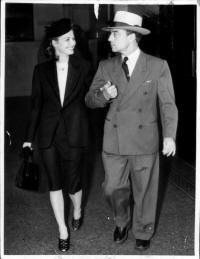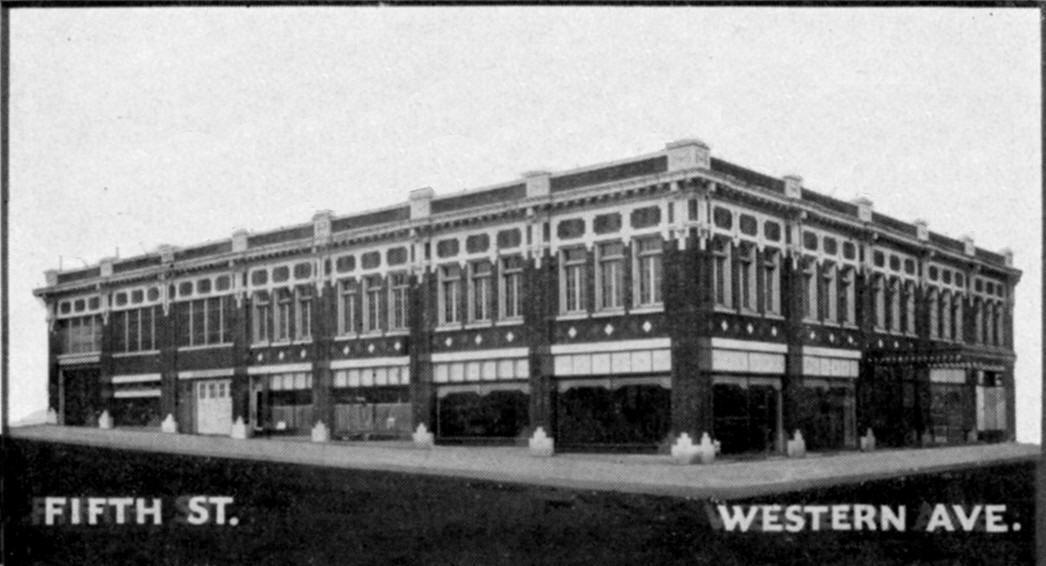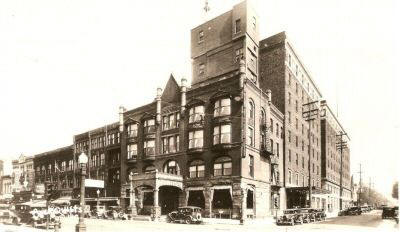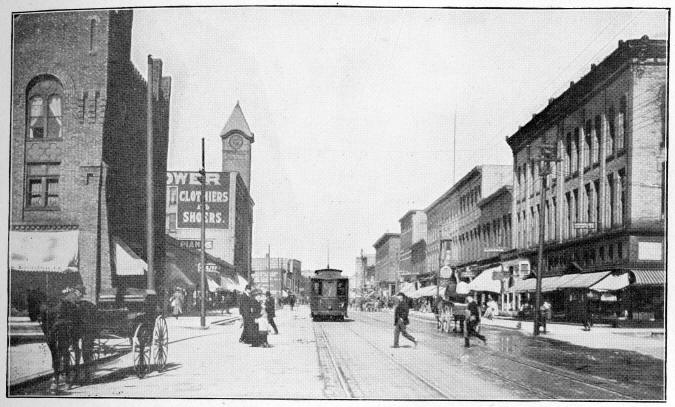|
Click here to view more images of Muskegon |
|
|
 |
En route from Los Angeles to Massachusetts, in
June of 1949 Buster Keaton
returned to Muskegon with his bride, the former Eleanor Norris,
a dancer in various movies. The couple married in 1940.
"When he knew he was to go to the East, Buster planned his trip
so that he would have at least two days in Muskegon," noted a
June 9, 1949 article in the Muskegon Chronicle. "The
Keaton's left California five days ago and drove here in easy
stages.
When he finally reached here, he was amazed at Muskegon.
Except for one day here in 1919, following his discharge from
the army, and a flying trip here in 1933, he hasn't seen
Muskegon since that last summer he spent here in 1916.
'I thought I was in the wrong place,' he said. 'One way
streets with traffic lights had me confused. Back 35 years
ago there wasn't much traffic in Muskegon and there were only a
few policemen and I knew them all. Now there is traffic all over
and everwhere I look there's a policeman.'" |
|
|
|
 |
|
Muskegon's Downtown Harbor. In the distance one can spot the
Continental Motors plant. Off to the right is the Occidental Hotel. In
the foreground is the old docks for the Goodrich Steamship line, now
known as the Mart Docks. |
|
|
|
|
DOWNTOWN MUSKEGON
from Seventh St. to Market St. |
 |
Union Station, Muskegon |
|
|
|
 |
 |
The Railway Express Agency, at Western Avenue
and Market sat between Union Station and the Amazon Knitting
Mill building. |
|
|
|
DOWNTOWN MUSKEGON
from Sixth St. to Fifth St. |
 |
 |
|
Lake View Hotel & Nite Club and the neighboring L & M Cafe. |
|
|
DOWNTOWN MUSKEGON
from Sixth St. to Fifth St. |
 |
 |
|
Following the collapse of Muskegon's lumber
industry in the 1890s, numerous city leaders and the city's Chamber of
Commerce used financial incentives to lure new and diversified business
to town. Among the early successes was the Amazon Hosiery Company
of Michigan City, Indiana. Relocated in 1895, the company, later
known as the Amazon Knitting Mill, built a mill on Western Avenue near
the waterfront. Designed by Chicago architect
Henry Ives Cobb, initial construction on the five story building,
much of which still dominates the landscape today, began in July 1895.
It was expanded again in 1899 and at various times during the industrial
boom that took place in Muskegon along the shore of Muskegon Lake. |
|
|
 |
|
An August 1920 Muskegon Chronicle article stated
Frank E.
Hathaway Inc. was "engaged in the construction of its immense
new garage building" at 201-203 Western Avenue and Fifth Street, across
from the Amazon Knitting Mill building. It was described as one of the
largest and best equipped garages in the state. Local residents might
recall it as the home of Hooper Brothers Chevrolet, occupants of the
building from the 1940's until the early 1960s.
|
|
|
DOWNTOWN MUSKEGON
Fifth St. to Fourth St. |
 |
|
|
 |
|
A 1927 image of Noble Buick, a second automobile dealership on West
Western Ave. |
|
|
 |
|
The offices of Safety Motor Coach Lines located behind Noble Buick on
Thayer Street in 1926. The buses were also known as "The Greyhounds."
The building would later serve as a grocery store, then as an annex to
the local sports arena. |
|
|
 |
|
Downtown Muskegon in 1928, looking west on Western Avenue from Fourth
Street. |
|
|
 |
 |
Build in 1933 on the site of the old Thayer
Lumber Company site near Muskegon Lake and the Goodrich Ferry
dock, the Mart Auditorium was originally designed as a
mulitpurpose facility, designed with retail space near the main
entrance and limited storage space
"Of special interest to the general public, the cavernous
interior would be equipped with piping for manufacturing an
artivicial ice surface," wrote Marc Okkonen in the Nov/Dec 1991
issue of Lake Michigan Coast magazine. "The seating
capacity for hockey and other ice events was 1,800, while over
4,000 could be accomodated for trade shows, conventions and
boxing." |
|
 The building would serve as home for Muskegon's earliest hockey
franchises, including the Muskegon Reds and the Muskegon Sailors of the
Michigan-Ontario League. In October of 1937, "The Mart" served
as the pre-season training facility for the Chicago Blackhawks. The building would serve as home for Muskegon's earliest hockey
franchises, including the Muskegon Reds and the Muskegon Sailors of the
Michigan-Ontario League. In October of 1937, "The Mart" served
as the pre-season training facility for the Chicago Blackhawks.
New demand for warehousing combined with economic pressures prompted the
West Michigan Dock and Market Corporation, owners of the building, to
convert the facility to a cold-storage unit. It would take 18 years for
the city to come up with a true replacement for the complex. |
 |
|
|
 |
 |
 |
|
Activity at the Mart Dock during the 1937 celebration of Muskegon's
Centennial. Note the ship at the lower far left in the photo.
Built of teak in 1840, it is the Success, a former Australian
prison ship. Used as a tourist attraction since 1890, the ship
toured the Great Lakes extensively in the 1920s and 1930s, including a
featured stop at the Chicago World Fair in 1933. |
 |
|
A photo looking south from West Michigan Dock and Market
Corporation property, taken during the Muskegon Centennial celebration
in 1937. The back side of the Union Station and Amazon Knitting
Mill buildings can be seen, as well as a downtown grocery store, Food
City Food Market. |
|
|
 |
|
In 1959, construction begins on the L.C. Walker Sports Arena just south
of The Mart. Placed on the corner of Western Ave and Fourth Street, the
modern structure was designed by Ralph Legeman and
Associates of Evansville, Indiana.
Considered specialists in the field, they had "planned 22 other arenas
and school gymnasium in the Middle West." The Food City building
shown in an earlier photo was a Plumbs Super Market and can be seen in
the center of this photo. It would later be annexed to the arena. |
 |
|
Build on the corner of Western and Fourth Street, Muskegon's new sports
arena replaced the old Mart Auditorium, which had closed its doors to
the public in 1942. Current Vice President and Presidential
candidate Richard M. Nixon presented the official dedication speech. |
|
|
|
Added to the landscape in October 1960, the L.C. Walker Arena brought a
a franchise in the International Hockey League to Muskegon.
Original called the Zephyrs - a reference to to a local business, the
Zephyr Petroleum Company, they would be later be renamed the Mohawks. |
|
|
|
|
DOWNTOWN MUSKEGON
Fourth St. to Third St. |
 |
|
Shows the W.J. Brinen Lumber Co. offices and the Brinen Block. |
|
|
 |
|
Corner of 4th and Western. Original home of Ginman Tire. |
|
|
 |
|
The Michigan Bowling Center. The location served a test site for new
Brunswick equipment. |
|
|
 |
|
|
 |
|
|
|
Lakos - The place for steaks. Originally A section of the brick Brinen
Block building was removed to expand this popular restaurant.
|
|
|
 |
|
A 1944 photo of the stunning Michigan
Theater. Restored to it's former glory, today it is known as the
Frauenthal Theater. Each October, the theater plays host to the
Buster Keaton Film Festival. |
|
|
 |
|
The corner of the Michigan Theater can be seen at the lower right of this
birds-eye view of the Muskegon downtown area. |
|
|
DOWNTOWN MUSKEGON
Third St. to Second St. |
 |
| A 1930's image of Muskegon's Occidental Hotel |
|
Muskegon's premier hotel, the
Occidental first opened its doors for business in 1868.
For the next 100 years, the structure would undergo
numerous alterations, reconfigurations and
reconstructions. Ultimately, the structure would
run the length of Third St to Clay Avenue and stretch
skyward eight stories. |
|
 |
 |
|
In March 1936, a spectacular fire broke out and destroyed
the older front section on Western Ave," notes historian Marc
Okkonen in his book,
Muskegon
Stories, "but no guests were harmed." |
 |
 |
|
The Occidental rebounded quickly with new frontage improvements made in
addition to the repairs to the fire-damaged floors," notes Okkonen. "By
this time, the Occidental was
THE hotel in Muskegon and
became the focal point of downtown activity during the forties
and fifties." |
 |
This image from
1920 shows the expansion of the Occidental along Third
Street to Clay. |
|
 |
The postcad view of the grand
structure would often show the hotel as viewed along
Third St. and Clay Ave. |
|
 |
 |
 |
 |
 |
|
|
 |
|
This 1937 Centennial Parade image by Beckquist's provides a nice
overview of the north side of Western Avenue. |
|
|
 |
|
Western at Third St across from the Occidental as shown in 1944.
This building would later be remodeled and house Drelles
Restaurant and Cocktail Bar. |
|
|
 |
115%;">Drelles -
originally operating on Jefferson St - opened at 388 W. Western
Ave in September 1951, across from the Occidental Hotel. It was
lost to a
fire
in January 1963.
|
Drelles - originally operating on Jefferson St - opened at 388
W. Western Ave in September 1951, across from the Occidental
Hotel. It was lost to a fire in January 1963. |
 |
 |
The postcard image shown to the left appears to be an alteration of
the photo shown above, with the two women walking away modified
to show one walking toward the camera. Note the alterations:
roads a flawless; building imperfections are touched up. |
|
|
 |
 |
|
|
 |
|
|
 |
 |
| Consumers Power Co in later years. |
The Garden Theater on the south
side of Western Avenue. |
|
|
|
DOWNTOWN MUSKEGON
Second St. to First St. |
|
|
 |
 |
On February 22, 1946 a
spectacular fire consumed two thirds of the storefronts on the
south side of the Western Ave. from the corner of Second St.
eastward toward First.
Again, Okkonen's book, Muskegon Stories provides the
detail. "The fire itself originated in the basement of the Hardy
store when papers in a storage bin ignited for undetermined
reasons and flame quickly shot up to the upper floors in the
rear of the building."
Fortunately, no one was seriously injured during the blaze.
However, a number of the buildings were lost, affecting a number
of businesses, including Walgreen's Drugs, Buel Shoes, Krautheim Jewelers,
Mangel's, a women's clothing store, Wright Jewelers, The W. D.
Hardy store, Neumode hosiery and the Daniels Company, an office
supply store.
Prior to the fire, "the W.D. Hardy company had already announced
plans for a new store to be built on Clay Avenue," Wrote
Okkonen, "and the destruction of their outdated Western Avenue
facility simply allowed them to relocate the planned store on
the site of the old one." |
 |
 |
|
|
|
 |
 |
|
 |
 |
 |
| Muskegon's downtown at Christmas, 1959. |
 |
Renamed Hardy-Herpolsheimer following a
merger with the Grand Rapids-based department store,
Herpolsheimers. |
 |
By the late 1950's Walgreens had moved down
the block from the corner of Second St. and Western to the
corner of First and Western. Muskegon Bank of Trust would
occupy the former location. |
|
|
|
|
|
 |
|
The north side of Western Avenue featured the Lyman Block and the
beautiful Regent Theater. |
 |
The Masonic Temple, before
modifications to the roof line and the building's
evolution into the home of Sears. The lodge would move
to a new building on Clay in front of Hackley Park in
September 1949. |
 |
The Lyman Block and
Regent Theater from around 1930. |
|
 |
 |
Looking up Western Avenue on the north side
of the street during the 1950s.
Notice the Lyman Block is now missing its clock tower and the Regent
Theater has a new marquee. |
 |
|
DOWNTOWN MUSKEGON
Intersection of First St., Market St. &
Western Ave. |
 |
|
The Muskegon Post Office was established in 1848. The current
building in downtown Muskegon, opened in 1938, was a depression-era
Works Progress Administration project. |
 |
 |
|
A photo taken that highlights the corner of Western Ave and Market
St. The Ritz Theater would later be known as the N-K. |
 |
 |
 |
Images of Muskegon's
Flatiron Building at the corner of Western and Market. A tobacco
shop, A. Schulte, was the occupant of the main strorefront for
years. Notice the changing sponsors of the rooftop bilboard
over time. |
|
 |

This view of Federal Square is from the late 1960s, when
Marvin Jewelers occupied the main storefront of the Flatiron
Building. |
|
|
DOWNTOWN MUSKEGON
from First St. to Jefferson St. |
 |
|
|
 |
Looking Up First St from
Western Ave. Note the Union National Bank Building to the
left. |
 |
|
|
|
|
|
The intersection of First St, Western Ave and Market Street, near the
Post Office. |

Western Ave. looking east beyond the Flatiron Building, toward
Jefferson Street. |
|
|
 |
1930's |
 |
1960's |
 |
| 1970's |
| |
| |
| The evolution of Western Avenue between
First and Jefferson. |
|
|
|
|
 A
view looking from Jefferson toward First St. A
view looking from Jefferson toward First St. |
 |
From Jefferson, looking up Western Ave -
before touchup and colorization... |
|
 |
In the romanticized postcard view, reality
is modified. The sky is beautiful. Sidewalks are cleaned and unnecessary signage
and trash cans disappear. Streets are repaved and lines painted
to present a more memorable view of the city. |
|
|
|
 |
 |
|
Corner of Western Ave. and Jefferson. |
|
|
 |
|
|
WESTERN AVE
from Jefferson St. to Terrace St. |
 |
 |
 |
|
In the early morning of February 6, 1937, a fire started in the basement
of Kline's Department Store, and engulfed both Kline's and Grossman's
Department stores as no firewall separated the buildings.
Grossman's rebuilt on the same site. A Federal Department Store
would ultimately occupy the Kline site. |
 |
 |
|
R & S Shoes Store - 193 W. Western Ave. |
 |
 |
 |
|
Coney Island Lunch - 200 W. Western Ave. |
 |
|
The corner of Terrace and Western, looking toward Pine St. |
 |
|
Looking north, up Terrace toward Western Avenue. |
|
|
|
|
DOWNTOWN MUSKEGON
Clay St. from Fourth St. to Terrace |
 |
 |
|
The new Masonic Temple, opened in 1949. |
|
|
 |
|
The Muskegon Chronicle building, on the corner of Clay and Third
Street, around the time it opened in 1928. |
|
|
 |
|
Muskegon Chronicle and Occidental Hotel, looking east down Clay. |
|
|
 |
|
Boyd's Uptown Service catty-corner from the YMCA. |
|
|
 |
|
|
|
Civic leaders and citizens gather in front of the post office in
September 1925 to kick off fundraising for the city's first YMCA.
(Among the group are members of the Muskegon High School band.
Note the drum to the right in the photo). Within a year, the money
would be raised and construction would begin. |
 |
|
The beautiful structure that they funded - Muskegon's first YMCA -
included a gymnasium and swimming pool at Second and Clay. |
 |
|
|
 |
 |
|
|
 |
|
People's State Bank building, above and below, located at the northeast corner of First Street and
Clay. |
 |
 |
 |
Federal Savings and Loan, on First Street
between Western and Clay before and after expansion into the old
Alantic and Pacific
storefront. |
|
|
|
 |
|
Towner Packard, located on Clay between 1st and Jefferson. |
|
|
 |
|
Muskegon's City Hall (above), at the corner of
Clay and Jefferson, as it appeared early in the century, and
(below) as it appeared in the late 1960s. Erected in 1881 at a cost
of $25,000, the structure also housed the fire department at the
rear of the building at the time it opened. Notice the removal
of the bell tower and ornate roof line from the original design
in the later images. Efforts to replace the building began in the
early 1960s and the
structure was ultimately demolished and replaced in 1970. |
|
|
 |
|
|
|
|
 |
|
A 1931 shot of the Terminal Arcade Building. |
|
|
 |
|
The Terminal Arcade Building at the corner of Clay and Jefferson. |
 |
 |
 |
|
|
|
|








































 A
view looking from Jefferson toward First St.
A
view looking from Jefferson toward First St.






















































